Spanner crabs are one crustacean that you don’t hear a lot about unless you’re sitting at a seafood restaurant table reading the menu. This is probably because you can’t just wander down to your local creek, throw a trap in from the bank and catch a feed of them. You need to venture offshore in a sea worthy vessel and put a bit of time into the preparation, and on a recent fishing trip to Wooli on the Northern New South Wales coast, I did just that.
Checking Willy Weather on arrival, I was greeted with four days straight of perfect offshore weather conditions. On the first day we thought it would be a good opportunity to take a couple of spanner crab traps out with us, just to see if they were around.
After stopping at a close inshore reef to gather live baits for our day’s fishing adventure, we then proceeded out to a spanner crab mark that a local had previously given us. If you do not know a friendly local, then ask at the local tackle shop or drop into the pub for a coldie and ask someone who the best person in town is to ask about where to start looking for spanner crabs.
The plan was to drop the traps and then go fishing for the day and pick them up on the way home.
The traps are simple, they consist of a 10mm steel rod frame approximately one square metre and a double layer of 50mm square nylon netting tied firmly with string within the framework. A gutter guard bait keeper is filled with fish frames from previous fishing trips, and zip tied in the middle of the trap on a bait keeper rope, which is attached to either side of the frame. These traps were home made, however they are made commercially through companies like Crab’n Gear Crab Pots in Brisbane and cost approximately $30 each.
Spanner crabs prefer bare sandy grounds anywhere, and are sometimes as deep as 100m. The GPS mark that we had was in about 26m of water, so we set the traps on a slope heading down to about 35m: We allowed for 60m of 10mm rope tied be to one corner of the frame, and over the side of the boat it went, bait keeper side down. After the trap hit the bottom, we let another 10m of rope out. The current was screaming, so we attached three 200mm ball floats to the end of the rope. Stainless Steel Carabiner style clips are used so that when you put out the required amount of rope you can tie a loop knot in the main line and clip the floats on to it. Painting the floats bright yellow or orange helps you locate them a lot easier later in the day, especially when you have the sun directly in your eyes.
Once we had the floats deployed out in the water, we marked the spot on the GPS and were off to the wider fishing grounds. After about 8 hours and one the best days fishing I’ve experienced for a long while, we headed back in to pick up the traps on the way home. We were hoping that we might have a couple of spanner crabs to complement our esky of snapper, pearlies and kingfish.
On our return the trap floats were nowhere to be seen on the GPS marks. The traps lay flat on the bottom, however with the strong current they had moved from the original drop zone, so some searching needed to be done. After a few minutes searching we motored up to the first of the two traps.
I used the gaff to assist in retrieving the float line and started to pull the trap up. The rope was tight and the trap felt heavy as I pulled it up through the water column. As it got closer to the boat I noticed a couple of crabs fall off and head back to the bottom of the ocean, not that it worried us, as there were still six or so attached to the netting. Up over the side and into the boat they came!
Once we had removed the legal-sized crabs and put them into the esky and iced them down, we placed the under-sized crabs back in the water. In Queensland, the legal size is 10cm carapace length and a 9.3cm carapace length in NSW.
We then moved onto looking for the second trap, which was only about 100m away. It was the other deckie’s turn to do the pulling. He was complaining all the time that it was heavy and, of course, I told him to toughen up. Soon enough, we had colour and realised that we hit the mother lode! Another 14 crabs came up over the side. Again, after sending the smaller ones back to grow up a little more, the esky was full of good-sized spanners and we had more than enough to feed the whole crew for the next couple of days.
From two traps and one drop, we had more than enough spanner crabs to feed a small army.
I did find it interesting that spanner crabs are naturally orange in colour, unlike muddies and sandies that go orange after you cook them.
Back at camp, it was time to cook them and have a feast.
First, we brought a cooker full of seawater to a rapid boil. The trick is to keep the saltwater in the live bait tank from the boat and use it in the cooker. After that, we placed the crabs in the cooking basket and lowered it in the boiling water. We used a big burner, as the water needs to be back on the boil quickly. It helps when you have a purpose built crab cooker. Once back to the boil, we cooked them for 13 minutes. After cooking, they were removed and placed in an ice slurry to cool down quickly. Cooling them quickly will prevent them from becoming over-cooked.
Cleaning is easy, just pull the flap at the bottom near the rear legs up and remove the main body shell. From there, you cut the body in half from the head to the tail and clean the guts out. There is hardly any the meat in the legs and claws. The bulk of the meat is in the body, and there is plenty. It’s a beautiful white-segmented flesh that pulls out and separates easily from the shell, which makes it easy to eat. The spanner crab has very sweet tasting meat and is one of the best tasting of all the crabs.
If you catch the mother lode and want to take some home at the end of your holiday, I would recommend that you cut them in half, clean the guts out and freeze them green (un-cooked), the meat will stay firmer when defrosted and cooked. The meat gets mushy when defrosted if you cook the crab first and then freeze it.
There is a little bit of mucking around to set the traps and find the right spot to drop them, however the reward at the end of the day can be fantastic and well worth the effort. Why not make spanner crabbing a part of your offshore trips?
Useful info and facts
Spanner crabs inhabit coastal waters along the east coast of Australia, from Yeppoon in Queensland to Nowra on the south coast of New South Wales.
The spanner crab (also known as the frog crab) is naturally red/orange in colour with some small white spots on the top of the carapace. Their claws are large and inward facing and look like a spanner. Unlike other crabs, which move in a sideways motion, spanner crabs move forwards and backwards. They dig themselves into the sand only exposing their eyes and wait for prey.
There is a spanner crab closed season in Queensland from midnight 20 November to midnight 20 December inclusive. The closed season protects spanner crabs when they are most vulnerable during their breeding season.
The legal size in Queensland is 10cm carapace length, measured from the centre spine to the mid carapace base along the back. There is a bag limit of 20 in possession. You are allowed four traps per person and they must be marked correctly with your full name and address. Only one trap per float is allowed in QLD.
In NSW there is a minimum legal length of 9.3cm carapace length and a recreational bag limit of 10 crabs in possession.
Spanner crabs spawn between October and February. Female crabs take about two years to mature and can produce two batches of eggs each season. Each batch can be around 120,000 eggs. Just remember that it is illegal to take egg-bearing (berried) female spanner crabs at any time of the year.
It is thought that it takes approximately 10 years for the spanner crab to reach its maximum size.
Reads: 9211
The traps used for spanner crabs are very simple, this one was homemade, but they can be purchased very cheaply.

The spanner crab is naturally red/orange in colour with some small white spots on the top of the carapace. Their claws are large and inward facing and look like a spanner.
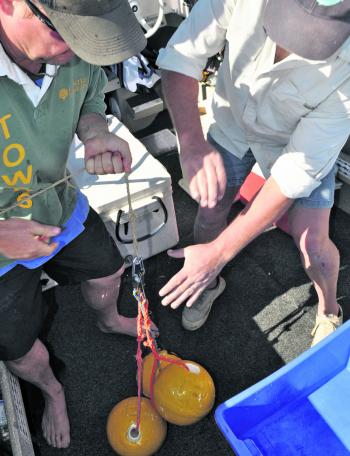
In places where there is strong current, extra floatation may be needed so you can find your trap at the end of the day.
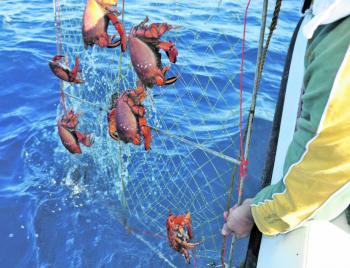
Success! The crabs have their legs tangled in the mesh and weren’t going to escape any time soon.
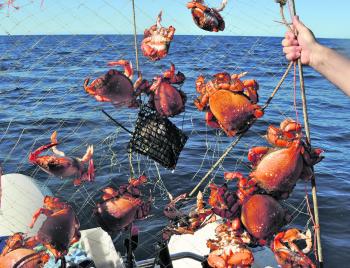
There’s easily enough there to feed at least a couple of hungry people.
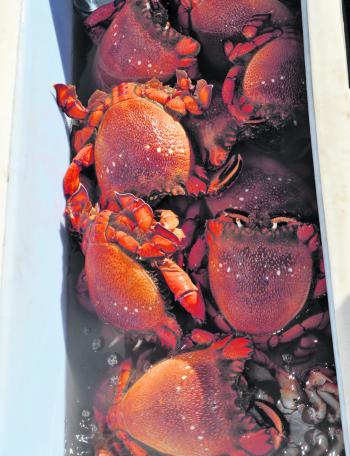
Spanners are impressive red/orange colour naturally, unlike muddies and sandies, which go this colour when cooked.
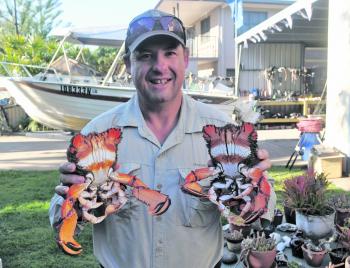
The inward facing claws is where the spanner crab gets its name.

A basket of crabs ready to be cooked in the boiling seawater from the livebait tank.
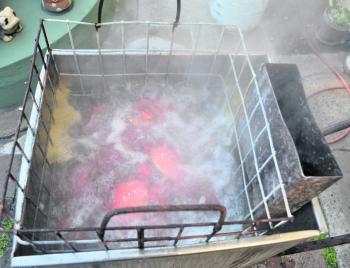
Once in the boiling water, tasty spanner crabs are just minutes away.
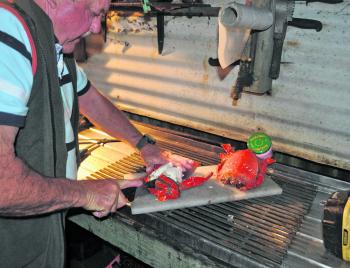
After they’ve been cooked, it’s just a matter of extracting the carapace meat, and you’ve got yourself some very tasty crab meat!




